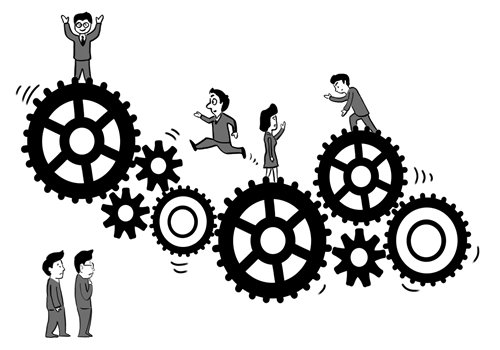Global value chain decides national prosperity

Illustration: Liu Rui/GT
Tunisia and Iran recently saw protests driven by economic hardships. Political turmoil and ethnic conflicts in Central Asia and the Middle East are linked to economic factors.
High unemployment rate, especially among youth, is the major challenge for these countries. Iran's unemployment rate is 12 percent, with more than 20 percent of young people struggling to find jobs. Worse still, 60 percent of Iran's population is below the age of 30.
Unemployment has become a sign of a country's marginalization in the process of globalization. Apart from a few countries that rely on the export of energy and raw materials to sustain their economy, Central Asia and the Middle East as a whole have seen decreasing participation in the global value chain (GVC).
In the era of globalization, no country can survive without participating in the GVC, the status of which determines a nation's development level, prospects and social stability.
The competition for GVC, which will directly affect state-to-state relations and a region's politics and economics, has become one of the key factors in global political, economic and security patterns.
GVC concerns global wealth distribution and social fairness, and is closely linked with a country's economic inequality and the possibility of emerging countries to join the GVC.
A number of countries along China's Belt and Road initiative route face such challenges. As the initiative advances, it will have to resolve the problem - how to help these countries take part in the GVC.
The core issue facing most developing nations is that apart from energy and raw materials, they do not have many resources to integrate with the GVC. Infrastructure is indeed of pivotal importance, but manufacturing carries more weight in a country's economic development.
Win-win cooperation co-exists with zero-sum competition in the era of globalization. When the global industrial system is being carved up, the expansion of a country's market share means squeezing other nations' products out of the market.
According to the theory of comparative advantage, a traditional economic concept, the expansion and speeding up of trade makes capital transfer to the regions with cheaper workforce. Hence developing countries like China can profit from the development of labor-intensive industry. However, not all developing countries can avail of the opportunity and share profits.
Besides, competition among developing countries becomes more intensive. The global industrial system, which is unlikely to be allocated evenly, will be reorganized and extended in this context. This is determined by the power of capital and whether a country has the conditions to develop manufacturing.
For certain countries with industrial foundations like India, South Africa and Brazil, it is not hard to manufacture products, but producing cheaper quality products and establishing its own industrial base is a tough proposition. It is not sustainable to protect production capacity with trade barriers.
Some countries cannot find a way to enter the GVC because of their social institutions, religion, traditions, production scales and undiversified economies. This means globalization will lead to more unrest in some regions and nations in the future. As Joseph E. Stiglitz, a Nobel laureate in economics, noted, "As has become evident, if we do not manage globalization so that it benefits all, the backlash - from the New Discontents in the North and the Old Discontents in the South - is at risk of intensifying."
The author is a senior editor with the People's Daily and a senior fellow with the Chongyang Institute for Financial Studies at Renmin University of China. dinggang@globaltimes.com.cn. Follow him on Twitter @dinggangchina

